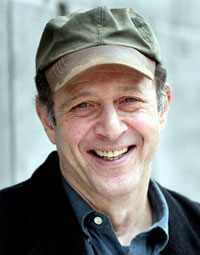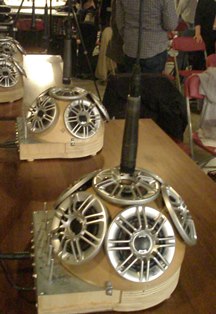
Reich's Music Receives Remarkable Tribute
A Steve Reich retrospective unlike any heard before in
Cincinnati took place Monday evening at Pallet 23 in Northside.

Presented by concert:nova, the event was a traversal of Reich’s works, from his experimental “Pendulum Music,” conceived in 1968, to his 1981 psalm setting “Tehillim.” Interleaved with it was music that influenced Reich or was influenced by him. The former included African drumming, Indonesian gamelan music and jazz; the latter, music by New York composer David Lang.
It was a sellout and in a non-traditional venue. Recently renovated Pallet 23 is an all-purpose, converted garage, which made acoustics, sight lines and restroom facilities a challenge, but there was little doubt that a good time was had by all.
Weaving it together for the benefit of Reich novices and those in need of a road map to the less familiar music was Michael Fiday, professor of composition at the University of Cincinnati College-Conservatory of Music. Fiday’s excellent spoken introductions explained Reich’s evolving modus operandi and pointed out salient points of each work on the program.
Participants included the Cincinnati Vocal Project, directed by Brett Scott, members of the Cincinnati Symphony Orchestra and Dayton Philharmonic, the Scott Belck/Phil DeGreg Quintet and faculty and students from CCM. The African Folklore Group provided a highly enjoyable demonstration of African drumming prior to the concert.
One of the pioneers of Minimalism (the reaction to mid-twentieth century modernism whose adherents also include Philip Glass), Reich pioneered new-found structural and harmonic simplicity, with a particular emphasis on rhythmic devices. He has found additional inspiration in non-Western and vernacular music.
There could not have been a better example of “simplicity”
than the opening “Pendulum Music,” which uses live microphones suspended over
speakers. To “perform” it – set in motion is a better description – four “players”
released microphones on cables allowing them to swing over speakers set onto a
table and pick up feedback tones. This constituted the “performance,” which
ended when the mikes’ arcs diminished to nothing and the power was
turned off. It made for an amusing sequence of grunts and squeals (and a salute
by Reich to composer John Cage).

With “Nagoya Marimbas” (1994), brilliantly performed by Matthew Hawkins and Jeffrey Luft, the crowd got a tasty sample of Reich’s phase-shifting technique, whereby players, working with a pattern or patterns of notes or rhythm, gradually alter it so that it goes in and out of sync, thereby creating contrapuntal interest. The exquisite craftsmanship of the piece was evidenced by Hawkins and Luft ending in precise rhythmic unison.
Reich’s “New York Counterpoint” (1995) illustrated Reich’s use of electronics. In it, clarinetist Jonathan Gunn played against ten clarinets and bass clarinets, all pre-recorded by former CSO principal clarinetist Richard Hawley. It was a virtual feast of clarinet, full of pulse and interlocking musical patterns.
The first half of the concert ended with part I of Reich’s 1971 “Drumming,” inspired by a visit to Ghana in which Reich experienced authentic West African drumming. Drummers Hawkins, Erica Drake, David Fishlock and Patrick Schleker wielded their sticks over eight tuned bongo drums in a feat of stunning virtuosity, stepping in and out of the work with amazing precision and ending precisely together (how do they do it?).
The Cincinnati Vocal Project – sopranos Amanda Carmen Bower and Mary Elizabeth Southworth and mezzo-sopranos Sarah Jackson and Audrey Walstrom – amazed in equal measure with their rendition of works by Lang and Canadian composer R. Murray Schafer on the first half. These included Schafer’s 1979 “Gamelan” from Partita 3, a work utilizing the Balinese/Javanese pentatonic scale in which each of the five notes is assigned a different syllable, i.e. “dang, deng, ding, dong and dung” (with the “ng’s” allowed to ring). It was a tour-de-force tongue-twister than left the crowd gasping.
Lang’s quixotic, patterned “I Want to Live” (2005) and “I lie” (2001), the latter sung in Yiddish, received performances that added a keen emotional tinge to the program.
The second half began with Miles Davis’ “All Blues” (1959) from his epochal album, “Kind of Blue.” The Scott Belck/Phil DeGreg Quintet – trumpeter Belck and pianist DeGreg, with Bryan Olsheski on tenor saxophone, Rusty Hollaway on bass and Jim Leslie on drums -- commanded one of the big bright spots of the evening with their performance, each raising the roof with his solo improvisation. (The ensemble remained after the concert for more music, making for a generous evening indeed.)
Reich’s “Tehillim,” led expertly by Scott, was the concert’s undoubted climax. A setting of verses from Psalms 19, 34, 18 and 150, it is based on the rhythms of the Hebrew text instead of the short, repeating patterns found in Reich's earlier music. It is more like a conventional vocal work, including more complex harmonies and marked a turning point in Reich’s style. Joining the prodigious singers of the Cincinnati Vocal Project was a chamber orchestra of 19, including six percussionists.
“Tehillim” draws on Reich’s Jewish heritage with its use of hand-clapping, tambourines with jingles and scriptural cantillation. It was a remarkable ensemble performance, with harmonic underpinning by the five string players, the winds amplifying the voices and the percussion showering rhythmic coloration over all.
The voices, again, were stunning, with their rapid, vibrato-less enunciation of the texts, all rapidly delivered and with pitches seemingly snatched out of the air. The final movement, Psalm 150, with its shower of “Hallelujahs,” brought the concert to a ringing, jubilant conclusion.